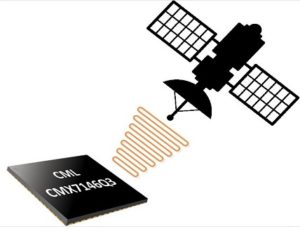
CML Microcircuits today announced the introduction of the CMX7146, a flexible data modulator that simplifies the design of transmit-only solutions using BPSK (binary phase shift keying) and differential BPSK modulation (also referred to as PRK, phase reversal keying, or 2PSK).
The CMX7146 generates precise baseband analogue in-phase and quadrature signals with programmable signal filtering. This generates with high accuracy a signal ready for transmission and suitable for up-conversion to an RF carrier of the user’s choice.
Compared to other BPSK solutions, the CMX7146 offers greater flexibility, with better support for low speed BPSK modulation. It provides extensive configuration in terms of data rates and modulation shaping, while enabling users to customize transmit frequencies and channel bandwidths using an external RF modulator.
By contrast, alternative products on the market leave customers to develop their own discrete solutions, which requires both RF and DSP programming knowledge. The integrated solution provided by the CMX7146 accelerates time to market, without the need for specialist knowledge.
David Brooke, Product Manager for CML’s Wireless Voice and Data products, said, “We are seeing a lot of interest in satellite IoT applications that monitor very remote equipment and send relatively small messages. For these kinds of functions, the new CMX7146 will give developers a quick and easy route to deploying a robust transmitter.”
BPSK is often used when durable, long range communication is needed. Its benefits include being relatively simple to demodulate and also extremely power efficient. These features have seen BPSK widely adopted for satellite applications (most recently in CubeSats), marine search and rescue (SAR) beacons and Industrial Internet of Things (IIoT) transmitters.
The CMX7146 supports raw (bits in, modulation data out) and preloaded (messages in, modulation data out) transmissions and features a transmit trigger input to enable precisely timed data transfers. A power amplifier ramping DAC can be employed to control transmission bursts, which can be synchronized as part of the transmit sequence. To increase flexibility in sensor interfacing and IIoT solutions, the CMX7146 integrates low power analogue to digital converters and four GPIO interfaces.
The new device is based on CML’s proven FirmASIC® technology, where device functionality is defined by a small configuration file that is loaded at power-up. This increases the flexibility and lifetime of an end-product, by taking advantage of future functionality upgrades provided by CML, such as alternative modulation schemes or over air protocols.
The new modulator complements CML’s existing range of wireless data modems aimed at applications in licensed frequency bands. In a typical system, the CMX7146 may be paired with CML’s CMX971 IQ modulator or CMX973 transceiver and a low-cost flash microcontroller that provides simple control functions as well as Function Image™ storage. Such a solution supports transmit frequencies from 100MHz to 1000MHz, and higher frequency systems can be supported by using alternative up-converter solutions.
The CMX7146 operates from a single 3.3V supply and is provided in a space-saving 48 lead QFN package.



















